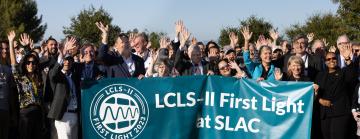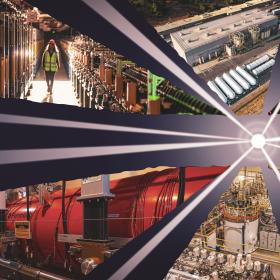Secretary of Energy Jennifer Granholm celebrates revolutionary X-ray laser upgrade at SLAC
The Secretary and other U.S. Department of Energy officials spent an afternoon touring SLAC’s energy labs, the superconducting-accelerator-powered Linac Coherent Light Source, and the Legacy Survey of Space and Time Camera. At a celebratory gathering, they commended staff for their vision and dedication in bringing LCLS-II “first light” to fruition.
Secretary of Energy Jennifer M. Granholm visited the U.S. Department of Energy’s SLAC National Accelerator Laboratory on Oct. 26 to celebrate the successful completion of the world’s most powerful X-ray laser. Along with DOE Under Secretary for Science and Innovation Dr. Geraldine Richmond and DOE Office of Science Director Dr. Asmeret Asefaw Berhe, she toured the lab and joined SLAC staff in a toast to “first light” – the first production of X-rays – at the Linac Coherent Light Source (LCLS) upgrade, LCLS-II.
U.S. Secretary of EnergyCongratulations on this unbelievable, remarkable achievement. America is now home to the world’s most powerful subatomic camera.”
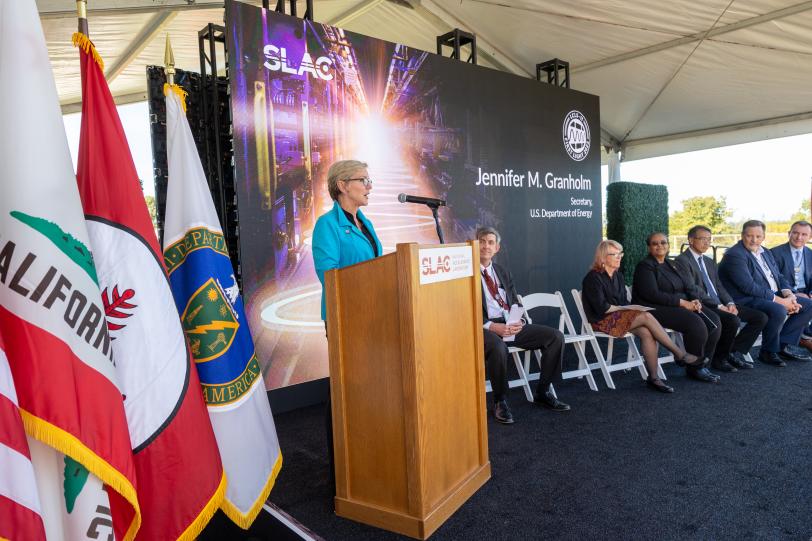
Ten thousand times brighter than the original, LCLS-II will fire up to a million X-ray pulses per second, transforming the ability of scientists to study nature’s processes at ultrafast speeds and atomic scales and keeping the nation at the forefront of X-ray science.
“Congratulations on this unbelievable, remarkable achievement,” Secretary Granholm said. “America is now home to the world’s most powerful subatomic camera.”
With the ability to capture atomic-scale snapshots of chemical reactions at the attosecond timescale – the scale at which electrons move – LCLS-II will provide unprecedented insights into chemical and biological reactions. Scientists will soon take advantage of the LCLS upgrade to examine the details of quantum materials and clean energy technologies, and to forge whole new areas of scientific investigation.
“With the world's most powerful X-ray laser, we can study the chemistry of new medicines,” Secretary Granholm said. “We can see how drugs interact with pathogens at the smallest molecular level, maybe even prevent the next pandemic. We can develop the future of clean fuel production, energy efficient batteries. We can design better catalysts for industrial processes. We can investigate the extreme conditions found in a fusion reactor or even the interior of our planet. And the efforts that made this project possible have additional meaning as well. For at its very core, the undertaking of scientific discovery is an exercise in bringing humanity closer together.”
DOE Office of Science DirectorLCLS-II demonstrates what can be achieved when we bring together the brightest minds from a diversity of backgrounds around a single audacious goal.”
Under Secretary Richmond, who has used lasers in her own scientific research, lauded the brightness, quality and consistency of the LCLS-II X-ray laser pulses. She highlighted the opportunities the facility will give the next generation of scientists. “LCLS will continue to develop and mentor an excellent scientific staff,” she said. “These people will become leaders in ultrafast X-ray laser science and technology.”
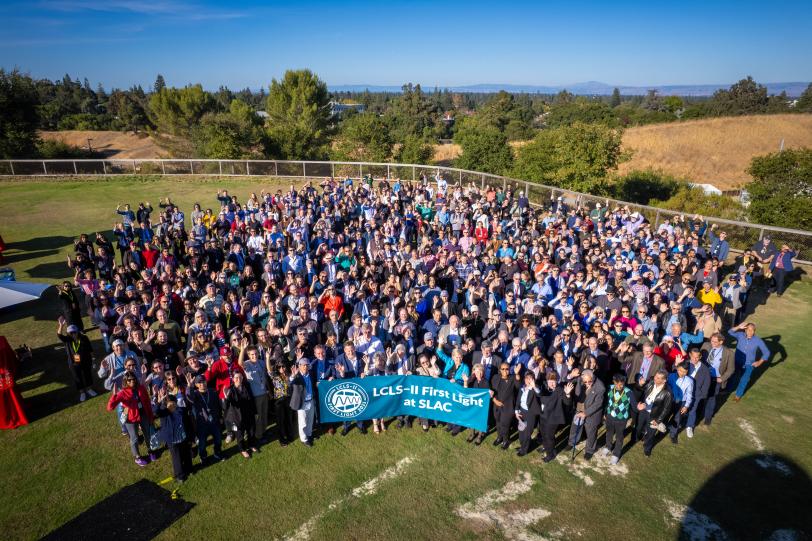
Director Berhe congratulated and thanked people at the five national labs that partnered in building the upgrade. “LCLS-II demonstrates what can be achieved when we bring together the brightest minds from a diversity of backgrounds around a single audacious goal,” she said. “The scale of this achievement is something that we do uniquely well at the DOE and in our national laboratories, institutions focused on building the tools and bringing together the talent that keeps the U.S. at the global forefront of innovation.”
Stanford University President Richard Saller led a toast to about 600 SLAC staff and collaborators gathered for the celebration, thanking everyone who contributed to the “mindboggling achievement.”
Great energy
Leading up to the afternoon celebration, SLAC Director John Sarrao hosted the DOE officials on a behind-the-scenes tour to learn about SLAC’s energy research and the inner workings of LCLS.
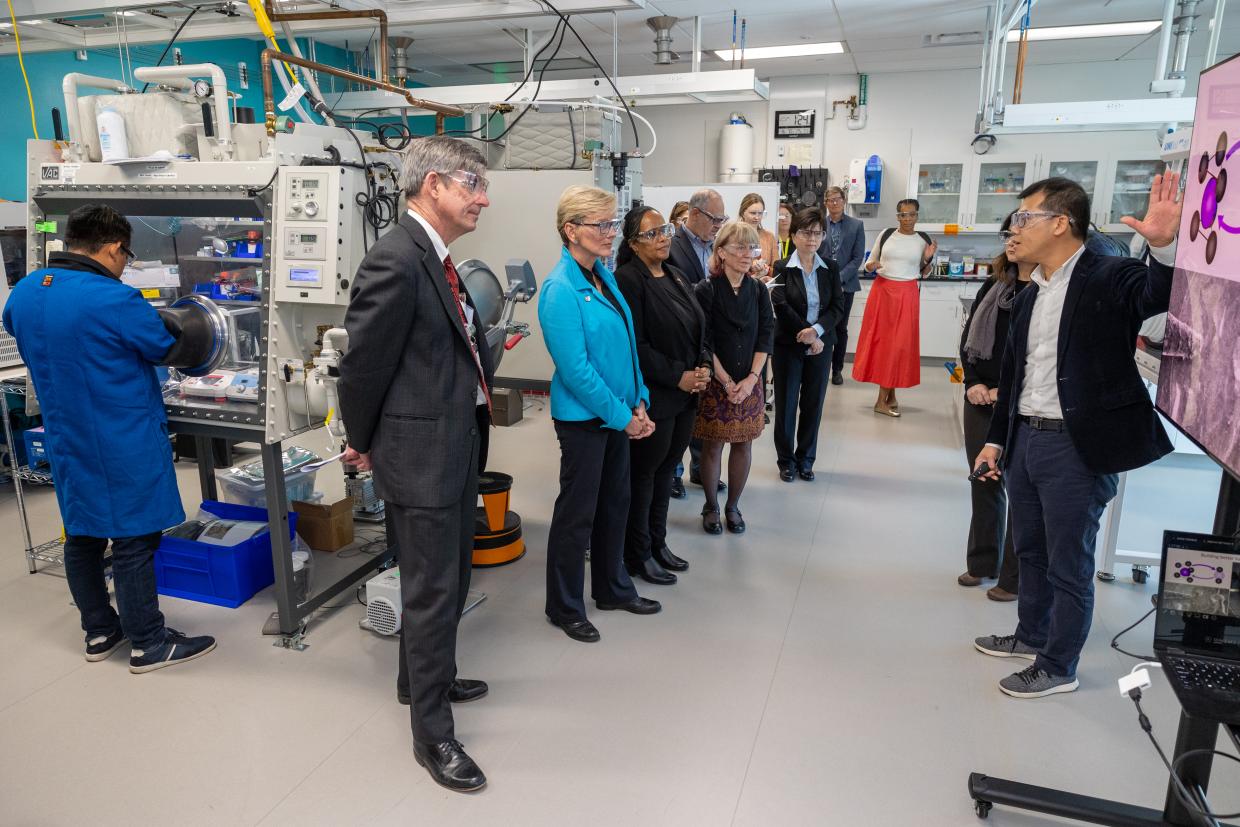
At the SLAC-Stanford Battery Center, they met scientists who are creating high-performing and safe batteries using Earth-abundant elements. Such batteries have the potential to decarbonize the grid and transportation around the world. Researchers also explained how they harness artificial intelligence to accelerate the learning and development cycles for emerging battery technologies.
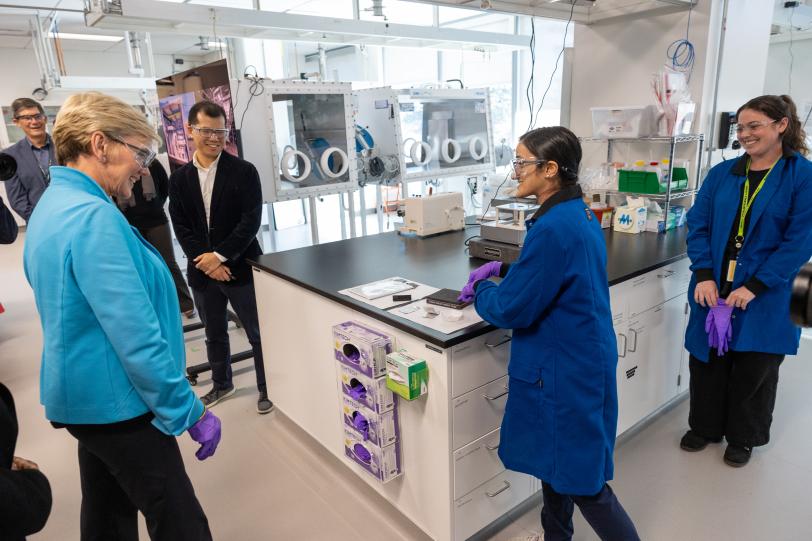
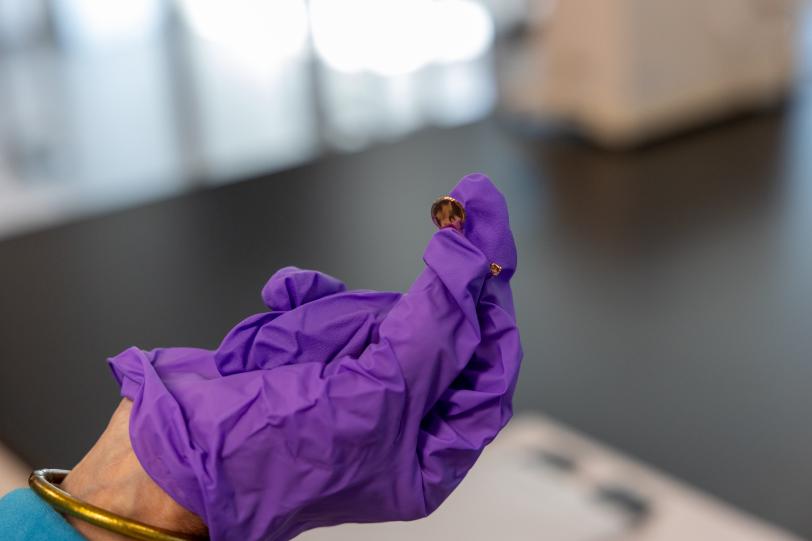
Secretary Granholm held tiny copper current collectors that the researchers call “music notes.” During X-ray studies of small “pouch cell batteries” made from graphite and Earth-abundant elements, the current collectors sense what is happening inside the batteries while they are operating. The studies – done at SLAC’s Stanford Synchrotron Radiation Lightsource (SSRL) – help scientists understand how batteries degrade and how to design safe, fast-charging batteries.
At the SUNCAT catalysis lab, the officials learned about how fundamental research can help design a new industry for fuels and chemistry with sustainability at its core. The center’s work in clean hydrogen production, CO2 capture and conversion, and renewable fertilizer – supported by the coupling of computational theory and experiment, the advantage of SLAC’s X-ray facilities, and partnerships with industry – help further the DOE mission to advance clean energy technologies within the decade.
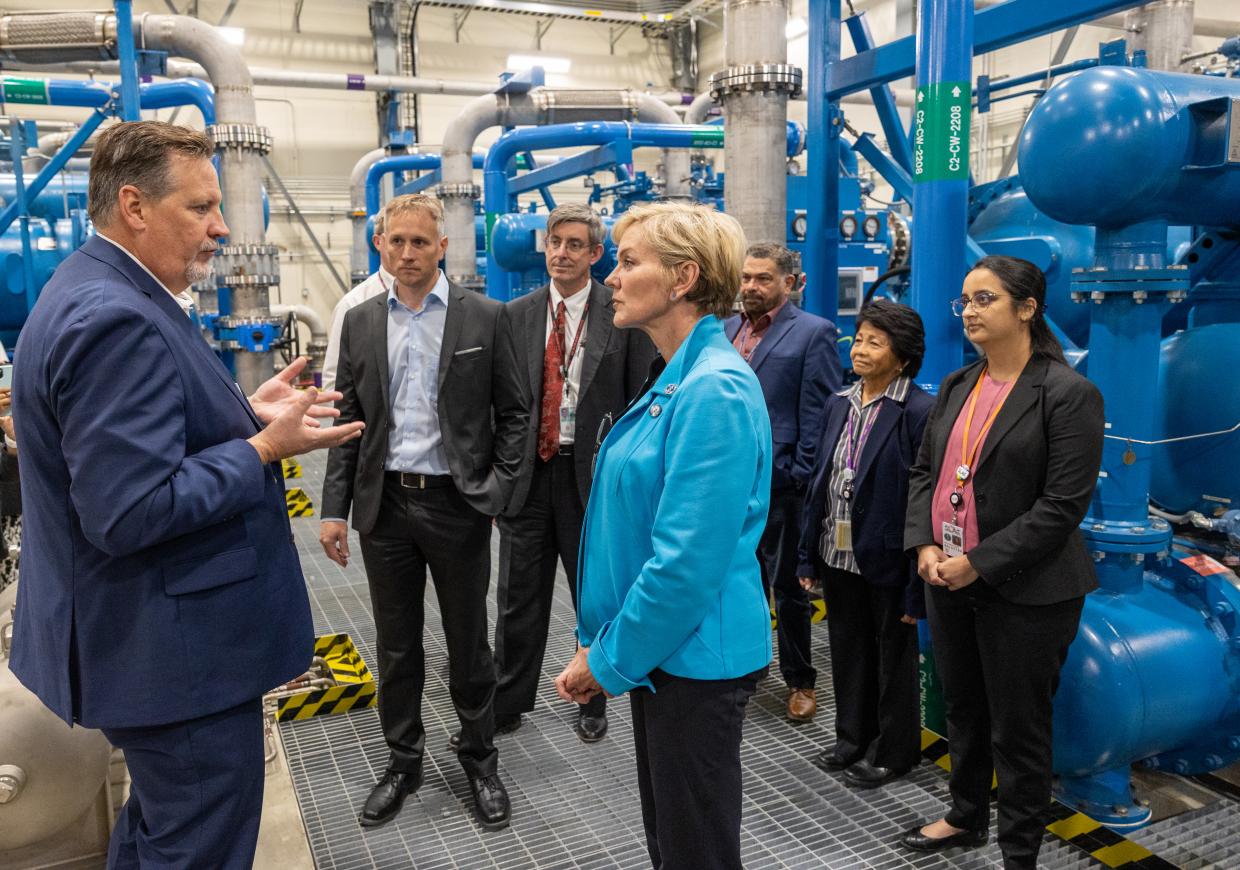
LCLS-II behind the scenes
Other tour locations highlighted the people and technologies that power LCLS. At the Accelerator Control Room, staff explained how the dozens of brightly lit screens allow them to monitor the status of the superconducting accelerator.
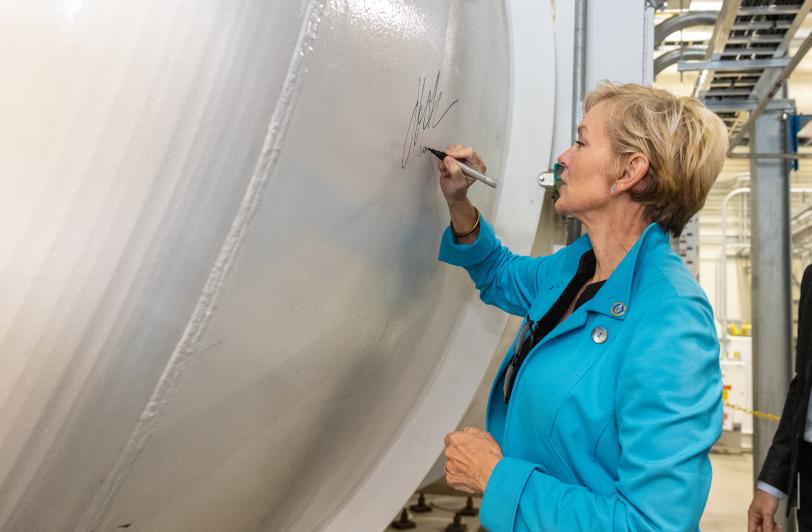
At the LCLS-II cryoplant, Secretary Granholm added her signature to the side of a cold box, one of the enormous liquid helium refrigerators that cool the 700-meter-long accelerator to 2 kelvins, a temperature colder than outer space. The officials met members of the LCLS-II cryogenic team, who described the years-long process of replacing part of the original copper accelerator with a series of 37 superconducting cryomodules built at Fermi National Accelerator Laboratory and Thomas Jefferson National Accelerator Facility and installed in the accelerator tunnel, 30 feet underground. The accelerated electrons are carried to the undulator hall, where a series of powerful magnets wiggles the electron beam to produce X-rays. The undulators for LCLS-II were designed and built by Lawrence Berkeley National Laboratory and Argonne National Laboratory.
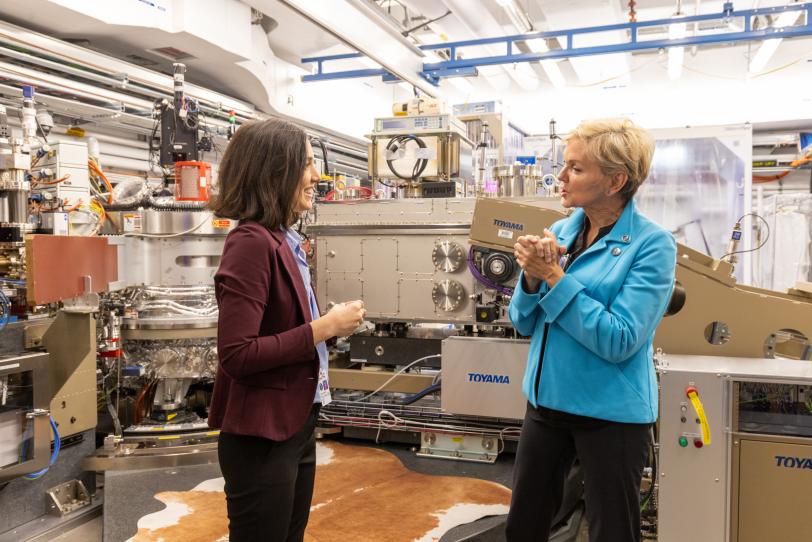
Following the trajectory of the laser beam, the tour went on to the LCLS Near Experimental Hall to visit the resonant inelastic X-ray scattering instruments called chemRIXS and qRIXS, where scientists will use LCLS’s ultrabright and fast X-rays to capture rare chemical events and reveal quantum phenomena in matter. For example, the speedy pulses of X-ray light can be used to capture snapshots of how molecules react to sunlight for the study of artificial photosynthesis.
Reflecting on the success of LCLS-II, the Secretary commended SLAC leadership and the importance of basic science research in reaching the nation’s clean energy goals, for instance by making solar panels and wind turbines more efficient and developing ways to use clean hydrogen fuel. Facilities like LCLS make such things “more efficient and better able to reach those goals,” she said. “Basic science is critical for us to be able to have clean energy, and that’s what this is all about.”
Billions of stars
The officials made a final tour stop at the Legacy Survey of Space and Time (LSST) Camera, the world’s largest digital camera with the largest lens ever built for ground-based astronomy. It was a rare opportunity to see the camera in the SLAC cleanroom while researchers put on the finishing touches before it’s moved to Chile and placed on the Vera C. Rubin Observatory’s Simonyi Survey Telescope. There it will take images of the Southern Hemisphere night sky for 10 years.
SLAC scientists described how the images will be combined to observe 20 billion galaxies, 20 billion stars in our own Milky Way and some six million objects in our solar system, and how scientists will use the data to study dark matter, the mysterious substance that makes up about 85% of matter in the universe, and dark energy, which is driving the accelerating expansion of the universe.
“We are honored to host Secretary Granholm, Under Secretary Richmond, Director Berhe and many other colleagues and collaborators today,” SLAC Director Sarrao said. The achievement of first light, he said, is “the culmination of a billion dollars and more than a decade of project. And as the Secretary articulated, now we have the chance to go and do great science for the good of the nation and the good of the world.”
Also in attendance were DOE Office of Science Deputy Director for Science Programs Dr. Harriet Kung and Associate Director of Science for Basic Energy Sciences Dr. Linda L. Horton.
LCLS and SSRL are DOE Office of Science User Facilities.
Contact
For questions or comments, contact the SLAC Office of Communications at communications@slac.stanford.edu.
SLAC is a vibrant multiprogram laboratory that explores how the universe works at the biggest, smallest and fastest scales and invents powerful tools used by scientists around the globe. With research spanning particle physics, astrophysics and cosmology, materials, chemistry, bio- and energy sciences and scientific computing, we help solve real-world problems and advance the interests of the nation.
SLAC is operated by Stanford University for the U.S. Department of Energy’s Office of Science. The Office of Science is the single largest supporter of basic research in the physical sciences in the United States and is working to address some of the most pressing challenges of our time.
